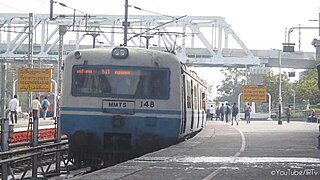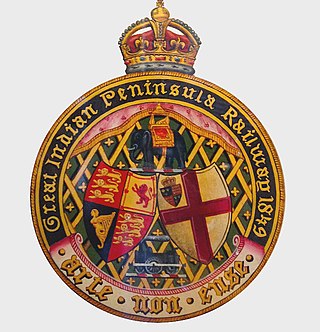This article needs additional citations for verification .(August 2013) |
| |||||
| Centuries: | |||||
|---|---|---|---|---|---|
| Decades: | |||||
| See also: | List of years in India Timeline of Indian history | ||||
Events in the year 1853 in India.
This article needs additional citations for verification .(August 2013) |
| |||||
| Centuries: | |||||
|---|---|---|---|---|---|
| Decades: | |||||
| See also: | List of years in India Timeline of Indian history | ||||
Events in the year 1853 in India.

Hyderabad is a city and the capital of Hyderabad Division in the Sindh province of Pakistan. It is the second-largest city in Sindh, and the eighth largest in Pakistan.

Hyderabad State was a princely state located in the south-central Deccan region of India with its capital at the city of Hyderabad. It is now divided into the present-day state of Telangana, the Kalyana-Karnataka region of Karnataka, and the Marathwada region of Maharashtra in India.

Berar Province, also known as the Hyderabad Assigned Districts, was a province of Hyderabad. After 1853, it was administered by the British, although the Nizam retained formal sovereignty over the province. Azam Jah, the eldest son of the 7th Nizam, held the title of Mirza-Baig ("Prince") of Berar.
Admiral Sir William Fanshawe Martin, 4th Baronet,, was a Royal Navy officer. As a commander, he provided valuable support to British merchants at Callao in Peru in the early 1820s during the Peruvian War of Independence. He became First Naval Lord in the Second Derby–Disraeli ministry in March 1858 and in that capacity acted as a strong advocate for the procurement of Britain's first ironclad warship. He went on to be Commander-in-Chief, Mediterranean Fleet and in that role provided important assistance during the Italian disturbances in 1860 and 1861, reformed the system of discipline in his fleet and developed a comprehensive system of manoeuvres for steam ships.

Roorkee (Rūṛkī) is a city and a municipal corporation in the Haridwar district of the state of Uttarakhand, India. It is 31 km (19 mi) from Haridwar city, the district headquarter. It is spread over a flat terrain under Sivalik Hills of Himalayas. The city is developed on the banks of Ganges Canal, its dominant feature, which flows from north–south through middle of the city. Roorkee is home to Asia's first engineering college Indian Institute of Technology Roorkee, formerly known as Thomson College of Civil Engineering. Roorkee is also known for the Roorkee Cantonment, one of the country's oldest military establishments and the headquarters of Bengal Engineer Group since 1853. A freight train ran in between Roorkee and Piran Kaliyar on 22 December 1851, this was two years before first passenger trains were started between Bombay and Thana in 1853 and 14 years after first freight trains ran in Chennai in 1837.

The Hyderabad Multi-Modal Transport System, commonly abbreviated as MMTS, is a suburban rail system in Hyderabad, India. A joint venture of the Government of Telangana and the South Central Railway, it is operated by the latter. The 90-kilometre (56 mi) system operates to cater the city of Hyderabad and the neighbouring suburban areas connecting Hyderabad, Secunderabad, Falaknuma, Lingampally, Medchal and Umdanagar with a total of 133 MMTS services. Currently 86 MMTS services are being operated due to the effect of COVID-19.

The Great Indian Peninsula Railway was a predecessor of the Central Railway, whose headquarters was at the Boree Bunder in Mumbai. The Great Indian Peninsula Railway Company was incorporated on 1 August 1849 by the Great Indian Peninsula Railway Company Act 1849 of the Parliament of the United Kingdom. It had a share capital of 50,000 pounds. On 21 August 1847 it entered into a formal contract with the East India Company for the construction and operation of a railway line, 56 km long, to form part of a trunk line connecting Bombay with Khandesh and Berar and generally with the other presidencies of India. The Court of Directors of the East India Company appointed James John Berkeley as Chief Resident Engineer and Charles Buchanan Ker and Robert Wilfred Graham as his assistants. It was India's first passenger railway, the original 21 miles (33.8 km) section opening in 1853, between Bombay (Mumbai) and Tanna (Thane). On 1 July 1925, its management was taken over by the Government. On 5 November 1951, it was incorporated into the Central Railway.
The Southern Region was a region of British Railways from 1948 until 1992 when railways were re-privatised. The region ceased to be an operating unit in its own right in the 1980s. The region covered south London, southern England and the south coast, including the busy commuter belt areas of Kent, Sussex and Surrey. The region was largely based upon the former Southern Railway area.

Mir Farqunda Ali Khan commonly known as Nasir-ud-Daulah, was Nizam of Hyderabad, a princely state of British India, from 24 May 1829 until his death in 1857.

Sir Mir Turab Ali Khan, Salar Jung I,, known simply as Salar Jung I, was an Indian nobleman who served as Prime Minister of Hyderabad State between 1853 until his death in 1883. He also served as regent for the sixth Nizam, Asaf Jah VI between 1869 and 1883.
The following lists events that happened during 1853 in Australia.

The Malton and Driffield Junction Railway, later known as the Malton and Driffield branch was a railway line in Yorkshire that ran between the towns of Malton, North Yorkshire and Driffield in the East Riding of Yorkshire.

Secunderabad Junction is a major intercity junction railway station and a commuter rail hub in the Hyderabad urban area. In the city centre, the station is in the South Central Railway zone of Indian Railways. Built in 1874 by the Nizam of Hyderabad during the British era, it was the main station of Nizam's Guaranteed State Railway until the Kacheguda railway station opened in 1916. The station was taken over by Indian Railways in 1951, when NGSR was nationalized. Its main portico and concourse are influenced by Nizamesque architecture. The station, which resembles a fort, is a tourist attraction in the twin cities of Hyderabad and Secunderabad.
Events in the year 1860 in India.

Koti Residency or British Residency or "Hyderabad Residency" is an opulent mansion built by James Achilles Kirkpatrick in the princely state of Hyderabad. Kirkpatrick was British Resident of Hyderabad between 1798 and 1805. It is a minor tourist attraction located in the suburb of Koti, Hyderabad.

Nizam's Guaranteed State Railway (NGSR) was a railway company operating in India from 1879 to 1950. It was owned by the Nizams of Hyderabad State, and its full name was His Exalted Highness, The Nizam's Guaranteed State Railway. The company began with a line built privately by the HEH, the Nizam, which was owned and operated by the company under a guarantee from the Hyderabad State, much to the dismay of the British authorities. Capital for the line was raised by issuing redeemable mortgage debentures. The Nizam's railway was eventually consolidated with the Hyderabad-Godavari Valley Railway (HGVR). In 1951, both the NGSR and the HGVR were nationalised and merged into Indian Railways.
Robertson, Martin and Smith was an engineering firm in Melbourne in the second half of the nineteenth century. The company manufactured the first steam locomotive to be built in Australia.
Events in the year 1851 in India.